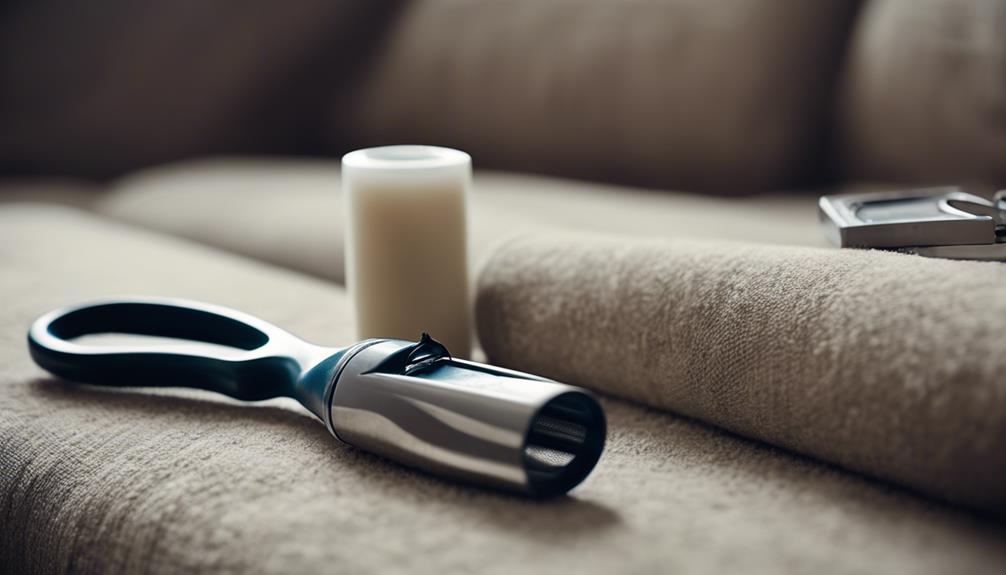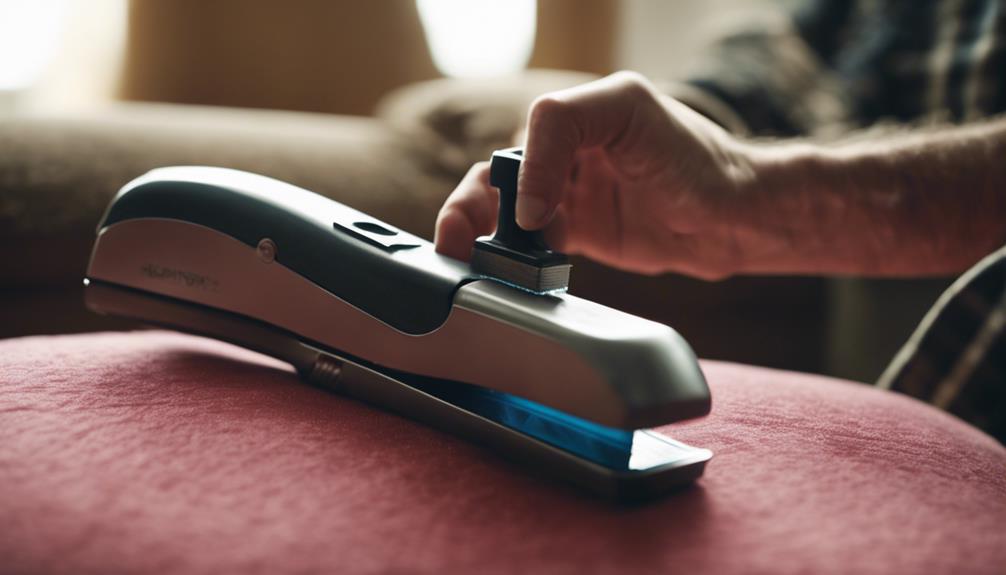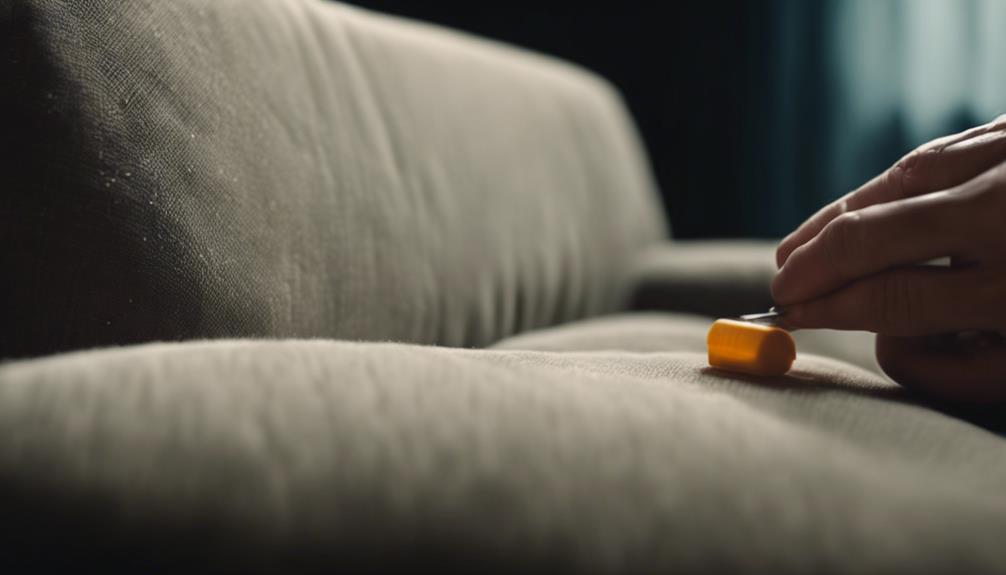To fix couch pilling, start by choosing smooth, tightly woven fabrics that reduce friction. Regularly inspect your couch for pilling and catch it early. For removal, use tools like a sharp razor, packing tape, and a vacuum with an upholstery brush attachment. Gently shave the fabric with the razor, tap to clear pills, and vacuum. Remember to use caution and test on a small area first. These steps will help restore your couch.
Causes of Couch Pilling
Frequently, couch pilling occurs when fibers rub together, creating small balls due to friction. This fabric pilling is a natural process that can be accelerated by daily use, washing, and abrasion. The friction causes loose fibers to accumulate on the surface of your couch, resulting in a worn-out appearance over time. It's common to see pilling on upholstered furniture like couches and sofas, but the good news is that with regular maintenance, you can prevent and manage this issue.
To remove pills from your couch, you can use a fabric shaver or a lint roller. Gently run the fabric shaver over the pilled areas to shave off the balls of fibers. Be cautious not to press too hard to avoid damaging the fabric.
Alternatively, a lint roller can pick up loose fibers and pills by rolling it back and forth on the affected areas. Regularly removing pills won't only improve the look of your couch but also help prevent further pilling in the future.
Types of Fabric Pilling
When it comes to fabric pilling, different types of fabrics react differently. Understanding the specific characteristics of each fabric can help you identify the causes of pilling, prevent its effects, and safely remove any pilling that has already occurred.
Fabric Pilling Causes
Fabric pilling causes vary depending on the type of fabric and its composition. Loose fibers twisting together due to friction from normal use and laundering are the primary culprits behind fabric pilling.
Man-made fibers such as polyester and nylon are more prone to pilling than natural fibers like cotton and silk. The weave and composition of different fabrics also play a significant role in their susceptibility to pilling. Fabrics with looser weaves or those made from shorter fibers tend to pill more easily compared to tightly woven fabrics with longer fibers.
Understanding these factors can help you choose fabrics that are less likely to pill and adopt maintenance practices that minimize the pilling effect. By selecting fabrics wisely and employing proper care techniques, you can reduce the occurrence of fabric pilling and prolong the life and appearance of your upholstery.
Preventing Pilling Effect
To minimize the pilling effect on your upholstery, selecting smooth, tightly woven fabrics can be an effective preventive measure. Fabrics like silk and cotton, which are natural, tend to pill less than man-made fibers such as polyester and nylon. Pilling happens when loose fibers intertwine and create small balls on the fabric's surface. By opting for tightly woven fabrics, you can reduce the chances of pilling occurring.
When choosing upholstery, consider the weave of the fabric. Fabrics with a tight weave have less space for fibers to break loose and form pills. Smooth fabrics also experience less friction, which is a common cause of pilling.
While pilling is a normal part of wear and tear, making informed fabric choices can help prevent excessive pilling on your furniture. By prioritizing tightly woven materials, you can enjoy your couch looking fresh and pill-free for longer.
Removing Pilling Safely
Understanding the varying types of fabric pilling is essential for effectively removing pilling from your couch. Different fabrics like cotton, polyester, and wool may exhibit distinct pilling characteristics. Pilling can be categorized into surface pilling, caused by friction and wear, and inherent pilling, stemming from the fibers themselves.
By recognizing the specific type of pilling on your couch, you can choose the most suitable method to remove it without causing damage. Regularly checking for pilling on your couch allows you to address it promptly, maintaining the sofa's appearance and extending its longevity.
Safely removing pilling from your couch is vital to prevent further deterioration and to keep it looking fresh and inviting. By using gentle yet effective techniques tailored to the type of fabric pilling present, you can restore your couch to its former glory and enhance its aesthetic appeal.
Identifying Pilling on Your Couch

When checking for pilling on your couch, look for small, fuzzy balls of fabric on the surface. Understanding the quality of your fabric can help you assess the severity of the pilling.
Pilling Appearance Analysis
Look closely at your couch's fabric surface to spot the telltale signs of pilling, which manifests as small, fuzzy balls. Pilling occurs when fabric fibers rub against each other due to friction, causing the fibers to tangle and form these unsightly balls.
These clusters of loose fibers not only detract from the appearance of your couch but also indicate that the fabric is deteriorating.
To analyze the pilling on your couch, check for areas where the fabric looks worn out or where you see these fuzzy balls accumulating. Run your hand over the surface gently to feel for any rough patches caused by the pilling.
Regularly inspecting your couch for pilling can help you catch the issue early on and take steps to prevent further damage. By identifying pilling early, you can maintain the aesthetic appeal of your couch and prolong its longevity.
Understanding Fabric Quality
Inspect the fabric of your couch closely to identify pilling, which occurs when loose fibers twist together due to friction from regular use.
Understanding fabric quality is essential in determining the likelihood of pilling on your couch. Man-made fibers like polyester and nylon are more prone to pilling compared to natural fibers such as cotton and wool. Fabrics with higher quality fibers are generally less likely to pill, preserving the appearance and comfort of your couch for longer periods.
When selecting upholstery for your couch, consider the fabric composition and quality to minimize the risk of pilling. Regular maintenance and cleaning routines can also help reduce friction, extending the lifespan of your couch fabric.
Prevention Methods Explained
To prevent fabric pilling on your couch, consider selecting durable fabrics and implementing regular maintenance routines. Fabric pilling manifests as small, fuzzy balls of fibers on the surface, giving your couch a worn-out look.
Identifying pilling involves noticing the accumulation of loose fibers on the fabric, often caused by friction from regular use and contact with abrasive materials. When choosing a fabric for your couch, opt for durable materials like polyester blends, nylon, or leather, as these are less prone to pilling.
Additionally, practicing regular maintenance such as vacuuming your couch with a soft brush attachment and using a fabric shaver to remove pills can help prevent pilling. By being mindful of the fabric you choose and maintaining your couch properly, you can keep it looking fresh and pill-free for longer.
Importance of Removing Pilling
Removing pilling from your couch is essential for maintaining its appearance and longevity. Those pesky pills not only detract from the beauty of your couch but can also impact its durability over time. By taking the time to address pilling issues, you're actively preserving the integrity of the fabric and ensuring that your couch remains comfortable and visually appealing.
In addition to enhancing the overall aesthetics of your living space, removing pilling can also save you money in the long run. By preventing further fabric damage, you can avoid costly upholstery repairs or even having to replace the entire couch prematurely. Promptly addressing pilling also helps contain the issue, preventing it from spreading to other areas of the couch.
Prioritizing the removal of pilling is a simple yet effective way to maintain the cleanliness, comfort, and longevity of your beloved couch.
Tools Needed for Pilling Removal

You need a sharp razor, packing tape, scissors, and a vacuum with an upholstery brush attachment to effectively remove pilling from your couch. These tools are essential for a thorough job and ensuring your upholstery looks good as new.
Make sure to work on a clean, flat surface to make the pilling removal process easier and more effective.
Effective Pill Removal Methods
Consider equipping yourself with essential tools like a new, sharp razor, packing tape, a vacuum with an upholstery brush attachment, scissors, and a clean, flat surface for effectively removing pilling from your couch.
When dealing with fabrics prone to pilling, such as wool or synthetics, using an electric shaver can be a quick and efficient method. Gently glide the electric shaver along the fabric's surface to remove the pills.
For more delicate fabrics, like cashmere or silk, it's advisable to opt for manual methods like a razor. After shaving off the pills, pressing packing tape onto the fabric can help pick up any remaining loose fibers.
Remember to vacuum the area afterward to guarantee a tidy finish. Whether you're working on a couch or clothing, these methods can help restore the appearance of your items by effectively eliminating pilling without causing damage to the fabric.
Essential Tools for Pilling
Equipping yourself with a new, sharp razor is crucial for effectively removing pilling from your couch or clothing. This tool, when free from moisture or soap strips, helps shave off the pills without damaging the fabric.
Additionally, packing tape can serve as an alternative pill remover by gently dabbing it over the affected areas to lift the pills. To tidy up after using the razor, a vacuum with an upholstery brush attachment will help collect any loose fibers left behind.
Before using the razor, it's advisable to trim any long loose fibers with scissors to prevent them from getting tangled in the razor. Finally, make sure you have a clean, flat surface to work on while removing pills from upholstery or clothing, as this will provide a stable and clear area for the pill removal process.
Step-by-Step Pilling Removal Process
To effectively eliminate pilling from your couch, start by making sure the upholstery surface is clean before proceeding with the removal process.
Use a new, sharp razor to gently shave along the fabric fibers to remove pills. Remember to tap the razor frequently to clear out accumulated pills during the shaving process.
After shaving, utilize a vacuum with an upholstery brush attachment to eliminate loose fibers. Press packing tape against the fabric to pick up any remaining loose fibers for a thorough cleaning.
Starting with a clean surface guarantees better visibility and effectiveness during the pilling removal process.
The shaving process should be done carefully and gently to avoid damaging the fabric while effectively removing the pills. Regularly clearing the razor ensures a smooth and efficient removal experience.
Finish off by vacuuming the area to get rid of any loose fibers left behind. The final touch of using packing tape helps in picking up any stubborn fibers for a pristine finish.
Precautions During Pilling Removal

Prioritize the cleanliness of the fabric before engaging in the pilling removal process to guarantee the prevention of trapping dirt and debris.
When using a razor or fabric shaver to remove pilling, exercise caution to avoid damaging the fabric. It's advisable to trim any loose fibers or threads before employing a fabric shaver for more effective results.
To prevent pulling or stretching the fabric, apply gentle pressure and use short strokes during the pilling removal process. Additionally, it's recommended to test the removal method on a small, inconspicuous area first to confirm it doesn't damage or discolor the fabric.
Benefits of DIY Pilling Removal
When addressing pilling issues on your couch, opting for a do-it-yourself approach offers numerous advantages. DIY methods for pilling removal aren't only cost-effective but also provide immediate solutions right in the comfort of your home. By choosing to tackle pilling on your own, you can save money that would otherwise be spent on professional services. These cost-effective DIY techniques empower you to take control of maintaining your fabric and upholstery.
Moreover, DIY pilling removal allows for personalized solutions tailored to the specific problems you're facing. You can choose the methods that work best for your couch fabric and adjust them as needed. This personalized approach ensures that you're treating the pilling issue effectively and efficiently.
Frequency of Pilling Maintenance

Regularly maintaining your couch for pilling should be scheduled every few months to prevent excessive fabric damage. The frequency of pill maintenance may vary depending on the fabric type and how often the couch is used.
For high-traffic areas or couches made of materials prone to pilling, more frequent maintenance may be necessary to keep them looking their best.
Experts in upholstery recommend incorporating pill maintenance into your regular cleaning routine to make certain that your couch stays in good condition. By staying proactive and addressing pilling issues promptly, you can extend the lifespan of your couch and reduce the need for more significant repairs down the line.
Consistent care and attention to pilling can help preserve the appearance and comfort of your couch, making it a more enjoyable and long-lasting piece of furniture in your home.
Maintaining a Pilling-Free Couch
To keep your couch free from pilling, regularly rotate the seat and back cushions to distribute wear evenly. This simple practice helps prevent excessive abrasion on specific areas of the fabric, reducing the likelihood of pilling.
When selecting a couch, opt for fabric materials such as silk, hemp, or cashmere that are less prone to this fabric defect, ensuring a longer-lasting appearance.
In addition to cushion rotation, vacuum your couch frequently using a soft brush attachment to eliminate loose fibers and dirt that can contribute to pilling over time.
Be mindful of the materials that come into contact with your couch, avoiding rough blankets or clothing that can increase friction and lead to more pilling.
If pilling does occur, consider using a fabric defuzzer or pill remover tool to effectively remove pills and maintain your couch's pristine look.
Conclusion
To sum up, by regularly removing pilling from your couch, you can keep it looking fresh and comfortable for years to come.
Remember, a stitch in time saves nine – taking care of pilling early can prevent bigger issues down the line.
So grab your fabric shaver and get to work, your couch will thank you!